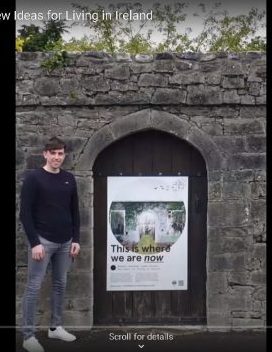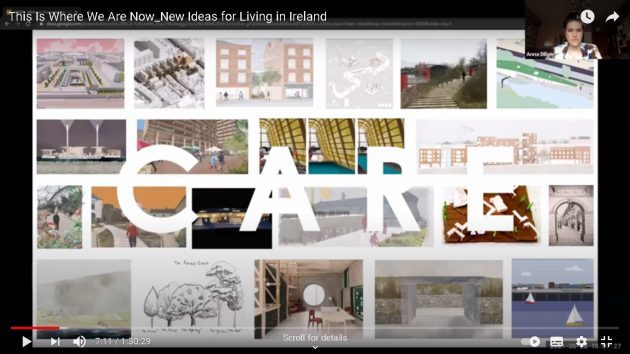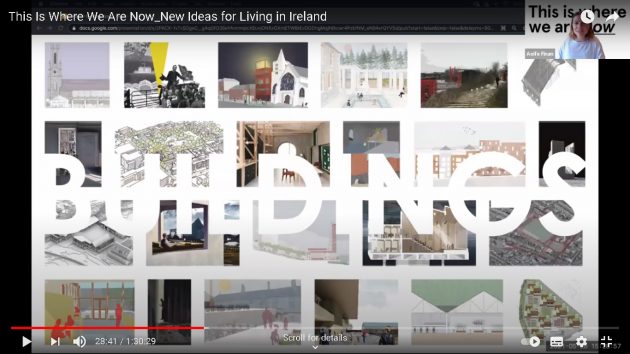Remote learning: Local Action:
New ideas for Living in Ireland
Webinar by University College Dublin M.Arch students
The last year has been challenging for us all, dealing with the pandemic affecting most aspects of life. This has been especially true of college students completing their degrees remotely, a particular disadvantage to architectural students where interaction and collaboration are an essential part of learning.
However, in spite of the restrictions, the final year architecture students in UCD embraced the difficulties and used the pandemic as an opportunity to reflect on wider issues and concerns and how the field of architecture might respond and address those. These ideas, expressed in their completed theses were collated and a webinar titled “This is where we are now” was set up by the students to relate these to a wider audience. The webinar was hosted by students Gary Hamilton and Eleanor Brady and held on the 28th of May, as part of UCD’s Festival 2021.
The overarching question students pondered was “do we return to where we were before or do we frame this time as an opportunity to rewrite where we are going?” Due to travel restrictions many students spent their year in their home locations, not just in Ireland. Working from home gave them a unique opportunity to look at where they live now, their local communities and question how they could bring new ideas to local conditions. This brought home the universality of architecture, against the background of the two great current challenges, Covid-19 and climate change. Having explored the resulting work, recurring ideas were identified that ran through all the work and were broken down into three overall themes: Care, Building and Future:
Care: Care for the environment, for oceans, for unloved, underused or derelict spaces – health and well-being of where we live and the care of ecosystems. The students reviewed the standards we use to design the built environment in the light of the climate crisis. They looked at health and well-being of buildings, occupation of small towns and the revitalisation of unused spaces.
Health – mental and physical and how the design of the built environment affects these. How housing can improve our well-being with good ventilation, lighting, sound attenuation and how they contribute to occupants taking ownership of the environment to create new sustainable communities. The theses reviewed aspects in the built environment that negatively impact on our mental health, reimagining derelict spaces and how they could be reused – the concept of reconnecting with the water – canals and the sea.
The subject of “Care” presented by students Anna Dillon and André Goyvaerts
Buildings: The students investigated the materiality of building. Many explored the possibility of reusing and reimagining existing buildings. The pandemic raised questions in relation to working from home, what happens to empty offices – can they be reused as new homes- or live/work spaces? In rural areas could unused buildings be reutilised as work hubs as an alternative to people working from home and so revitalise the communities within the towns. How could existing housing blocks be reused rather than be demolished – for example the ground floors of social housing blocks how might they be reimagined?
They also looked at changes to traditional social rituals in Ireland, unused churches maybe reimagined as community spaces, cafes, schools or other educational facilities. Public bathing was a common theme looking at how the canals could become new social amenity centres – how sea bathing facilities could be reimagined. Cultural buildings – the fact that they have been closed for over a year look at how cultural activities could be facilitated utilising public spaces again revitalising smaller towns – integrating new structures with old or existing.
The subject of “Buildings” presented by students Emily-Ann Byrne and Aoife Finan
Future: Students looked at what they thought the future might look like post –Covid-19 but also in light of the climate crisis. Housing, where would it be located, how would remote working affect the psyche of the city. Is there a need for demolition or could existing buildings be reimagined and reused – reintegrating the threatened biodiversity and help occupants to live more sustainably. Looking at the spaces between buildings – maybe unloved, derelict open spaces revitalised and the creation of connections between buildings and public spaces so that they act as a whole not separate entities.
The subject of “Future” presented by students Ross Brennan and Luke Dillon
The webinar was refreshing and inspiring, shedding a light on the ideas and concerns of the emerging architects of the future. Concern for the environment, for communities and how architecture can improve the quality of life and surroundings for us all. The work and the webinar can be viewed on the UCD Architecture Youtube channel. https://www.ucdarchm.com/march-2b




